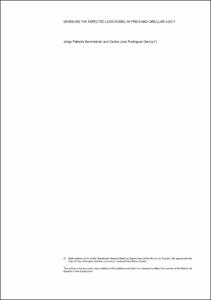Registro completo de metadatos
| Campo DC | Valor |
|---|---|
| dc.contributor.author | Pallarés Sanchidrián, Jorge |
| dc.contributor.author | Rodríguez García, Carlos José |
| dc.date.accessioned | 2020-04-02T08:06:53Z |
| dc.date.available | 2020-04-02T08:06:53Z |
| dc.date.issued | 2019-05 |
| dc.identifier.uri | https://repositorio.bde.es/handle/123456789/11209 |
| dc.description | Artículo de revista |
| dc.description.abstract | As a result of the Great Financial Crisis, the G-20 requested that the accounting standard setters change the model for estimation of credit losses (or “provisions”). Following this mandate, the “expected loss” model replaced the “incurred loss” model in order to favor a more timely and adequate estimation of credit losses. We explain that, from a conceptual perspective, the expected loss model may help to achieve this goal because it requires credit losses to be recognized from the origination of the transaction and the level of provisions to be increased when the credit quality of the transaction worsens but it has not defaulted. The scant data available so far seem to confirm these conceptual insights. Some criticisms of the expected loss model allude to its pro-cyclicality, without considering that an efficient accounting standard should not repress volatility, by giving a false image of stability, as the incurred loss model did. The expected loss model allows for greater subjectivity in its application, but this subjectivity must be understood in a positive manner so as to anticipate more accurately future credit losses, not leaving room for earnings management practices. We campaign for an adequate implementation of the standard as an essential tool to achieve the objectives of all stakeholders (preparers, auditors, regulators and supervisors). |
| dc.format.extent | 18 p. |
| dc.language.iso | en |
| dc.relation.ispartof | Revista de Estabilidad Financiera / Banco de España, 36 (primavera 2019), p. 147-164 |
| dc.relation.hasversion | Versión en inglés 123456789/11161 |
| dc.rights | Reconocimiento-NoComercial-CompartirIgual 4.0 Internacional (CC BY-NC-SA 4.0) |
| dc.rights | In Copyright - Non Commercial Use Permitted |
| dc.rights.uri | https://creativecommons.org/licenses/by-nc-sa/4.0/deed.es_ES |
| dc.rights.uri | http://rightsstatements.org/vocab/InC-NC/1.0/ |
| dc.title | Unveiling the expected loss model in IFRS 9 and Circular 4/2017. |
| dc.type | Artículo |
| dc.identifier.bdebib | 000465597 |
| dc.identifier.bdepub | REFI-2019-36-147 |
| dc.subject.bde | Contabilidad financiera |
| dc.publisher.bde | Madrid : Banco de España, 2019 |












